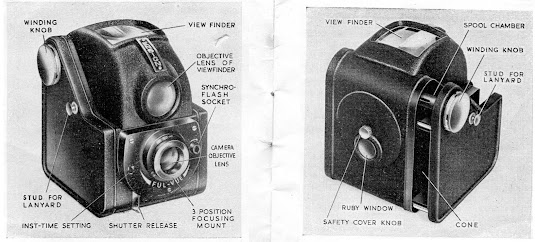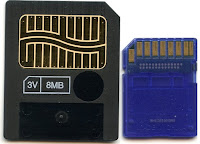And then there were those of us who took things a stage further: home processing. For that you needed another whole cupboard full of esoteric paraphernalia.
It was Duncan across the road who got me started. His dad developed his own photographs and had given him a packet of out-of-date contact papers. They darkened in light, so objects such as leaves or your fingers would leave a white silhouette. You could even print crude photographs from negatives in the same way. The problem was that the contact papers would continue to darken until they were completely black all over. Your silhouette or image lasted only five minutes at most.
Well, one thing led to another, and before long I was making proper prints from negatives. I turned the yellow shed into a dark room, got a device for exposing photographic paper to illuminated negatives for just a few seconds, and began to spend my pocket money at the local chemists on packets of contact papers and bottles of photographic chemicals: developer to bring out the images and fixer to make the prints light-proof.
With the idea of taking photographs of London, we went down on the train to stay for a few days with Duncan’s grandma in Hounslow, where turboprop aeroplanes rumbled low overhead smelling of paraffin, and we had to be up early so her night-shift lodger could use the same bed. We freely roamed the Underground on our Rail Rovers (would you let two fourteen-year-olds do this now, naïve as we then were?), went to the Science Museum, saw the Houses of Parliament and The Monument, howled with laughter at The Road to Hong Kong in which Bob Hope and Bing Crosby get fired into space in a capsule designed for monkeys, and got free tickets for the live Friday lunchtime broadcast of The Joe Loss Pop Show with guests The Barron Knights and regular singer Ross McManus – Elvis Costello’s dad. Actually, it was a bit disappointing to find the guests were only The Barron Knights whose act basically consisted of making fun of other groups. A few weeks earlier they’d had The Rolling Stones and The Searchers.
 |
| London Airport, 1964 (renamed Heathrow in 1966) |
I took my new Kodak Brownie Starmite camera (12 images of 4x4 cm on rolls of 46mm 127 sized film), but none of the photographs I developed at home were much good. Only one commercially developed shots came out, taken at London Airport (not yet called Heathrow): the last frame on a colour film left over from an earlier family holiday.
 I used the Brownie camera for the next ten years but with black and white film because colour was so expensive. I could occasionally afford the flash bulbs though: disposable one-use plastic coated bulbs filled with magnesium and oxygen, sparked off by a battery. They melted when fired, leaving ash-filled knobbly glass inside the protective plastic coating.
I used the Brownie camera for the next ten years but with black and white film because colour was so expensive. I could occasionally afford the flash bulbs though: disposable one-use plastic coated bulbs filled with magnesium and oxygen, sparked off by a battery. They melted when fired, leaving ash-filled knobbly glass inside the protective plastic coating.Black and white film was easy to develop at home if you had a light-proof developing tank, and one conveniently materialised at Christmas. The most difficult part was getting the film into the tank. You had to separate it from its light-proof backing paper and feed it into a plastic spiral which went inside the tank, but you had to do it completely in the dark. The yellow shed was just about dark enough for contact printing – you could do that in the dim orange glow from the contact printer – but film was ultra-sensitive and had to be handled in pitch-black. You had to wait for night time, and then found yourself with head and arms beneath thick bedclothes, trying not to breathe on the film, getting hotter and hotter and gasping for oxygen. You really had to get a move on.
Once the film was safely in the tank the lid stayed on and you could work in daylight. It was essentially the same process as developing contact prints. You filled the tank with Johnson Universal Developer for a fixed amount of time, emptied it and replaced the developer with Johnson Acid Hypo Fixer for around a further thirty minutes, rinsed everything thoroughly with lukewarm water, took the film out of the tank and just like in Blow Up hung it to dry weighted by a bulldog clip to prevent curling. After that the negative images on the developed film could be contact printed (I have archived a copy of the Paterson instruction booklet which shows and explains the process).
It was always exciting to take the shimmering wet film out of the tank to see the dark negatives for the first time and try to make sense of what they were. You could easily have forgotten because the earlier images on the film would often be several months old. When you then printed the photographs it was fascinating to watch the images emerge under the surface of the developing fluid, trying in the dim light to judge when they were ready.
I was never more than an occasional snapshot photographer, but my uncle gave me his old enlarger for making prints bigger than the negatives and I avidly watched the BBC series Better Photography on Saturday mornings through the autumn of 1965.
Now, of course, everything is digital and so another of those experiential manual skills has been lost to the electronic world: the exercise of judgement, the physical manipulation of the materials, the strange saliva-inducing smell of the chemicals, the darkroom perfectionism – all gone! Instead, we compile our digital albums, Photoshop our images, blog about what fun things used to be and can be vaingloriously creative without physical skills at all. It’s good in many ways, but not always as satisfying.
- Maurice Fisher’s website Photographic Memorabilia is a real treasure trove of images and information about photographic film processing and equipment.







.jpg)











































